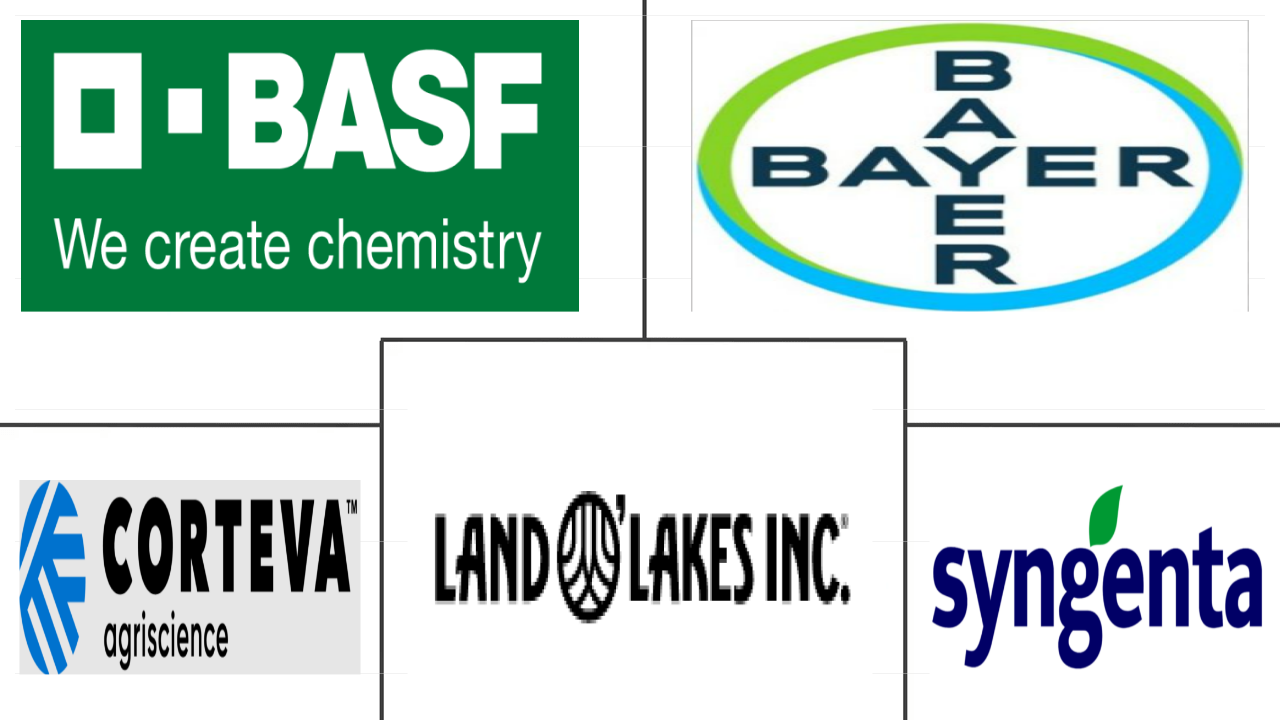Market Size of north america seed Industry
| Icons | Lable | Value |
|---|---|---|
|
|
Study Period | 2017 - 2030 |
|
|
Market Size (2024) | USD 25.6 Billion |
|
|
Market Size (2030) | USD 36.98 Billion |
|
|
Largest Share by Breeding Technology | Hybrids |
|
|
CAGR (2024 - 2030) | 6.32 % |
|
|
Largest Share by Country | United States |
|
|
Market Concentration | High |
Major Players |
||

|
||
|
*Disclaimer: Major Players sorted in no particular order |
North America Seed Market Analysis
The North America Seed Market size is estimated at 25.6 billion USD in 2024, and is expected to reach 36.98 billion USD by 2030, growing at a CAGR of 6.32% during the forecast period (2024-2030).
25.6 Billion
Market Size in 2024 (USD)
36.98 Billion
Market Size in 2030 (USD)
7.73 %
CAGR (2017-2023)
6.32 %
CAGR (2024-2030)
Largest Market by Crop Family
57.81 %
value share, Grains & Cereals, 2023
It is the largest segment as the United States is one of the largest producers of corn and wheat globally and has the availability of improved cultivars and transgenic seeds.
Largest Market by Country
76.47 %
value share, United States, 2023
It is a leading producer of high-value crops such as corn, soybean, and cucumber, and the adoption of biotech crops as well as hybrid seeds is highest in the country.
Fastest-growing Market by Crop Family
6.96 %
Projected CAGR, Solanaceae, 2024-2030
It is the fastest growing due to the increased production and growing demand from the processing industry and its adaptable nature to wider growing environments.
Fastest-growing Market by Country
6.76 %
Projected CAGR, United States, 2024-2030
The United States is one of the leading producers of grains and vegetables. Favorable weather conditions and high export demand for vegetables led to increased cultivation.
Leading Market Player
26.10 %
market share, Corteva Agriscience, 2022

The company has made extensive product innovations and effective partnership strategies. It has recently launched its new gene-editing technology in corn hybrids and other crops.
Advancements in plant breeding techniques and growing investments by key players in the market for improved varieties are estimated to drive the market
- In North America, the hybrid seed segment dominated the markets in terms of volume and value. It accounted for 81.4% of the total seed market value in 2022. This is because hybrid seeds include superior traits such as higher yields, improved disease resistance, and consistent performance, meeting the demands of modern agriculture.
- The market value of the hybrid segment increased by 27.2% between 2017 and 2021 due to advancements in plant breeding techniques, allowing the development of new plant varieties with desired traits by modifying the DNA of the seeds and plant cells. These innovative traits drive the sales of hybrid seeds in the region.
- Open-pollinated varieties require fewer inputs and are less expensive and more affordable for low-income farmers. As a result, in 2022, they were valued at USD 4.23 billion.
- The companies are heavily investing in new plant technologies due to the increasing demand for advanced, improved varieties. For instance, in 2022, Bayer AG opened its new canola seed production site in Cranbrook, B.C. This site manages Bayer's canola pre-foundation, foundation, and experimental plot seed operations for Canada and Chile.
- Wheat is the largest cultivated crop among all the crops, with open-pollinated varieties accounting for 29.3% of the total open-pollinated varieties and value share of hybrid derivatives in 2022. The advantages of open-pollinated varieties and derivatives include being well adapted to the local environment, allowing them to grow stronger, and requiring fewer inputs.
- The advancements in plant breeding techniques and integration of superior traits, such as higher yields and improved disease resistance in hybrid seeds, are estimated to drive the market's growth during the forecast period.
The United States dominated the North American seed market due to higher area and higher usage of commercial hybrids
- In 2022, North America was the major leading seed market, accounting for 34.5% of the global seed market in terms of value. In the region, the United States was the largest seed market, and it had a market share of 76.2% in 2022, followed by Canada and Mexico.
- In 2022, row crops in the United States accounted for 36.1% of the global row crop seed market, and vegetable crops accounted for 22.8% of the global vegetable seed market. This was due to the larger area under cultivation and higher usage of commercial seeds.
- Canada is the second major seed market, accounting for 13.9% of the North American seed market in 2022. According to Statistics Canada, Ontario, Quebec, and British Columbia accounted for about 55.2%, 34.0%, and 3.1%, respectively, of vegetable production in 2022. The major vegetable crops grown in the country are tomato, green peas, carrot, green beans, onion, cabbage, and broccoli. Canada's protected cultivation areas include tomatoes, peppers, cucumbers, and lettuce.
- The cultivation of vegetable crops under protected conditions is booming in Mexico. Sinaloa accounted for the largest area under protected cultivation in 2022, followed by Jalisco with 3,310 ha, Baja California with 2,647 ha, Mexico with 1,624 ha, Chihuahua with 1,496 ha, Sonora with 1,175 ha, and Puebla with 1,045 ha. Majorly grown vegetables in protected cultivation are tomatoes, bell peppers, and cucurbits.
- The increase in the hybridization by seed companies, the increased investments, especially in Mexico, which is the largest importer of hybrid seeds, and the North America Free Trade Agreement facilitating imports and exports among North American countries are expected to boost the market significantly during the forecast period.
North America Seed Industry Segmentation
Hybrids, Open Pollinated Varieties & Hybrid Derivatives are covered as segments by Breeding Technology. Open Field, Protected Cultivation are covered as segments by Cultivation Mechanism. Row Crops, Vegetables are covered as segments by Crop Type. Canada, Mexico, United States are covered as segments by Country.
- In North America, the hybrid seed segment dominated the markets in terms of volume and value. It accounted for 81.4% of the total seed market value in 2022. This is because hybrid seeds include superior traits such as higher yields, improved disease resistance, and consistent performance, meeting the demands of modern agriculture.
- The market value of the hybrid segment increased by 27.2% between 2017 and 2021 due to advancements in plant breeding techniques, allowing the development of new plant varieties with desired traits by modifying the DNA of the seeds and plant cells. These innovative traits drive the sales of hybrid seeds in the region.
- Open-pollinated varieties require fewer inputs and are less expensive and more affordable for low-income farmers. As a result, in 2022, they were valued at USD 4.23 billion.
- The companies are heavily investing in new plant technologies due to the increasing demand for advanced, improved varieties. For instance, in 2022, Bayer AG opened its new canola seed production site in Cranbrook, B.C. This site manages Bayer's canola pre-foundation, foundation, and experimental plot seed operations for Canada and Chile.
- Wheat is the largest cultivated crop among all the crops, with open-pollinated varieties accounting for 29.3% of the total open-pollinated varieties and value share of hybrid derivatives in 2022. The advantages of open-pollinated varieties and derivatives include being well adapted to the local environment, allowing them to grow stronger, and requiring fewer inputs.
- The advancements in plant breeding techniques and integration of superior traits, such as higher yields and improved disease resistance in hybrid seeds, are estimated to drive the market's growth during the forecast period.
| Breeding Technology | ||||||||
| ||||||||
| Open Pollinated Varieties & Hybrid Derivatives |
| Cultivation Mechanism | |
| Open Field | |
| Protected Cultivation |
| Crop Type | |||||||||||||||||||||||||||||||||
| |||||||||||||||||||||||||||||||||
|
| Country | |
| Canada | |
| Mexico | |
| United States | |
| Rest of North America |
North America Seed Market Size Summary
The North America Seed Market is experiencing significant growth, driven by advancements in plant breeding techniques and the increasing demand for hybrid seeds. The hybrid seed segment dominates the market due to its superior traits, such as higher yields and improved disease resistance, which align with the needs of modern agriculture. This segment's growth is supported by substantial investments from major companies in new plant technologies. Open-pollinated varieties, while less expensive and requiring fewer inputs, continue to play a crucial role, particularly for low-income farmers. The market's expansion is further bolstered by the region's vast arable land, diverse climatic zones, and advanced farming practices, which collectively enhance the cultivation of row crops and contribute to global agricultural trade.
In terms of market size, North America holds a significant share of the global seed market, with the United States leading the region. The cultivation of corn and soybeans, supported by favorable government policies and stable domestic demand, underscores the region's agricultural strength. The market is fairly consolidated, with major players like BASF SE, Bayer AG, Corteva Agriscience, Land O’Lakes Inc., and Syngenta Group dominating the landscape. These companies are actively expanding their portfolios and investing in research and development to meet the evolving demands of the agricultural sector. The North America Free Trade Agreement also facilitates the import and export of seeds, further enhancing market dynamics and growth prospects.
North America Seed Market Size - Table of Contents
-
1. MARKET SEGMENTATION (includes market size in Value in USD, Forecasts up to 2030 and analysis of growth prospects)
-
1.1 Breeding Technology
-
1.1.1 Hybrids
-
1.1.1.1 Non-Transgenic Hybrids
-
1.1.1.2 Transgenic Hybrids
-
1.1.1.2.1 Herbicide Tolerant Hybrids
-
1.1.1.2.2 Insect Resistant Hybrids
-
1.1.1.2.3 Other Traits
-
-
-
1.1.2 Open Pollinated Varieties & Hybrid Derivatives
-
-
1.2 Cultivation Mechanism
-
1.2.1 Open Field
-
1.2.2 Protected Cultivation
-
-
1.3 Crop Type
-
1.3.1 Row Crops
-
1.3.1.1 Fiber Crops
-
1.3.1.1.1 Cotton
-
1.3.1.1.2 Other Fiber Crops
-
-
1.3.1.2 Forage Crops
-
1.3.1.2.1 Alfalfa
-
1.3.1.2.2 Forage Corn
-
1.3.1.2.3 Forage Sorghum
-
1.3.1.2.4 Other Forage Crops
-
-
1.3.1.3 Grains & Cereals
-
1.3.1.3.1 Corn
-
1.3.1.3.2 Rice
-
1.3.1.3.3 Sorghum
-
1.3.1.3.4 Wheat
-
1.3.1.3.5 Other Grains & Cereals
-
-
1.3.1.4 Oilseeds
-
1.3.1.4.1 Canola, Rapeseed & Mustard
-
1.3.1.4.2 Soybean
-
1.3.1.4.3 Sunflower
-
1.3.1.4.4 Other Oilseeds
-
-
1.3.1.5 Pulses
-
-
1.3.2 Vegetables
-
1.3.2.1 Brassicas
-
1.3.2.1.1 Cabbage
-
1.3.2.1.2 Carrot
-
1.3.2.1.3 Cauliflower & Broccoli
-
1.3.2.1.4 Other Brassicas
-
-
1.3.2.2 Cucurbits
-
1.3.2.2.1 Cucumber & Gherkin
-
1.3.2.2.2 Pumpkin & Squash
-
1.3.2.2.3 Other Cucurbits
-
-
1.3.2.3 Roots & Bulbs
-
1.3.2.3.1 Garlic
-
1.3.2.3.2 Onion
-
1.3.2.3.3 Potato
-
1.3.2.3.4 Other Roots & Bulbs
-
-
1.3.2.4 Solanaceae
-
1.3.2.4.1 Chilli
-
1.3.2.4.2 Eggplant
-
1.3.2.4.3 Tomato
-
1.3.2.4.4 Other Solanaceae
-
-
1.3.2.5 Unclassified Vegetables
-
1.3.2.5.1 Asparagus
-
1.3.2.5.2 Lettuce
-
1.3.2.5.3 Okra
-
1.3.2.5.4 Peas
-
1.3.2.5.5 Spinach
-
1.3.2.5.6 Other Unclassified Vegetables
-
-
-
-
1.4 Country
-
1.4.1 Canada
-
1.4.2 Mexico
-
1.4.3 United States
-
1.4.4 Rest of North America
-
-
North America Seed Market Size FAQs
How big is the North America Seed Market?
The North America Seed Market size is expected to reach USD 25.60 billion in 2024 and grow at a CAGR of 6.32% to reach USD 36.98 billion by 2030.
What is the current North America Seed Market size?
In 2024, the North America Seed Market size is expected to reach USD 25.60 billion.

